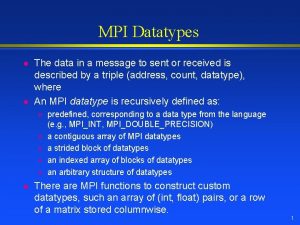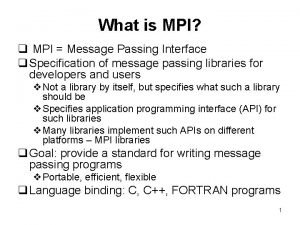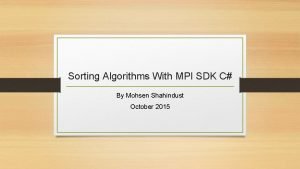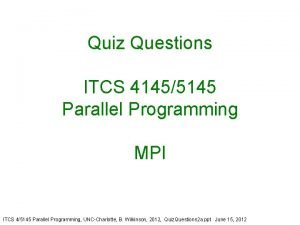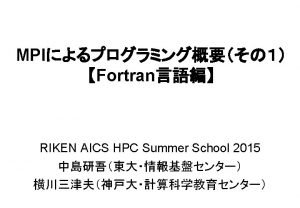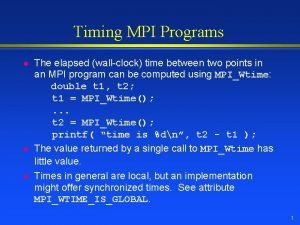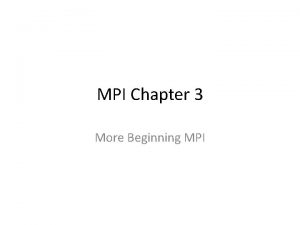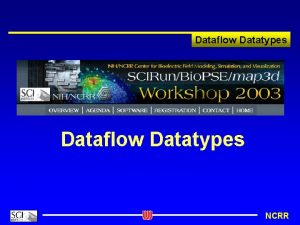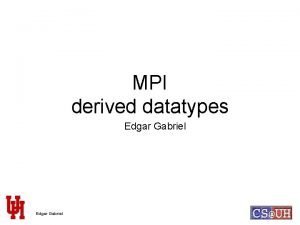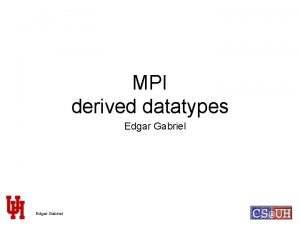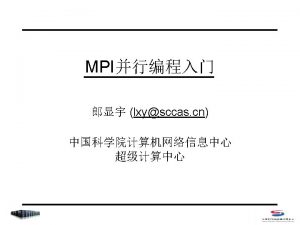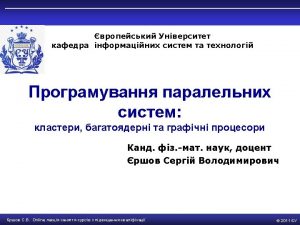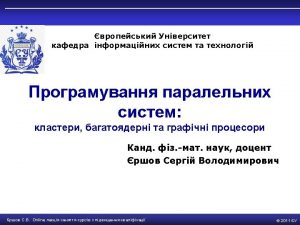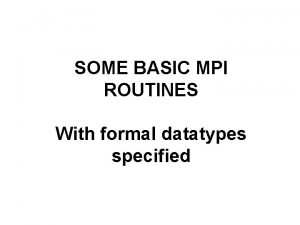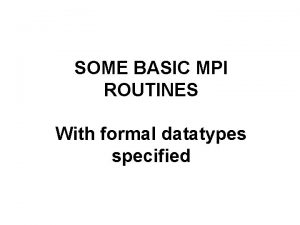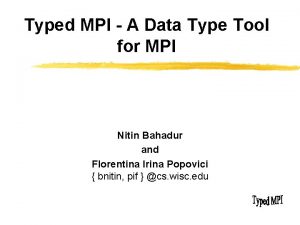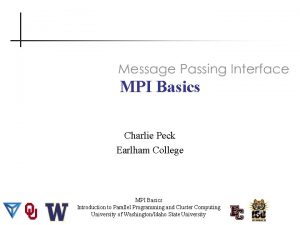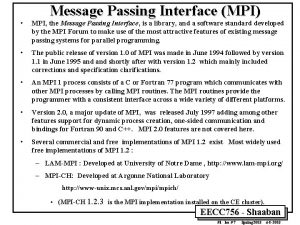MPI Datatypes l l The data in a


















- Slides: 18

MPI Datatypes l l The data in a message to sent or received is described by a triple (address, count, datatype), where An MPI datatype is recursively defined as: » predefined, corresponding to a data type from the language (e. g. , MPI_INT, MPI_DOUBLE_PRECISION) » a contiguous array of MPI datatypes » a strided block of datatypes » an indexed array of blocks of datatypes » an arbitrary structure of datatypes l There are MPI functions to construct custom datatypes, such an array of (int, float) pairs, or a row of a matrix stored columnwise. 1

Why Datatypes? l Since all data is labeled by type, an MPI implementation can support communication between processes on machines with very different memory representations and lengths of elementary datatypes (heterogeneous communication). l Specifying application-oriented layout of data in memory » can reduce memory-to-memory copies in the implementation » allows the use of special hardware (scatter/gather) when available 2

Non-contiguous Datatypes Provided to allow MPI implementations to avoid copy l Extra copy Network » Not widely implemented yet l Handling of important special cases » Constant stride » Contiguous structures 3

Potential Performance Advantage in MPI Datatypes l l Handling non-contiguous data Assume must pack/unpack on each end » cn + (s + r n) + cn = s + (2 c + r)n l Can move directly » s + r’ n » r’ probably > r but < (2 c+r) l MPI implementation must copy data anyway (into network buffer or shared memory); having the datatype permits removing 2 copies 4

Performance of MPI Datatypes l Test of 1000 element vector of doubles with stride of 24 doubles (MB/sec). » MPI_Type_vector » MPI_Type_struct (MPI_UB for stride) » User packs and unpacks by hand l Performance very dependent on implementation; should improve with time 5

Performance of MPI Datatypes II l Performance of MPI_Type_Vector » 1000 doubles with stride 24 » Performance in MB/sec Equivalent Type_Struct Platform IBM SP Blue Pacific Vendor MPI 3. 79 2. 94 MPICH 6. 71 1. 02 SGI O 2000 Blue Mountain 7. 63 3. 09 20. 2 2. 6 43. 8 Intel Tflops Red 32. 3 3. 29 MPICH is Vendor MPI 34. 7 User 9. 52 6

Datatype Abstractions l l Standard Unix abstraction is “block of contiguous bytes” (e. g. , readv, writev) MPI specifies datatypes recursively as » count of (type, offset) where offset may be relative or absolute » MPICH uses a simplified form of this for MPI_Type_vector (and so outperforms vendor MPIs) l More general form would provide superior performance for most user-defined datatypes » MPI implementations can improve 7

Working With MPI Datatypes l An MPI datatype defines a type signature: » sequence of pairs: (basic type, offset) » An integer at offset 0, followed by another integer at offset 8, followed by a double at offset 16 is – (integer, 0), (integer, 4), (double, 16) » Offsets need not be increasing: – (integer, 64), (double, 0) l An MPI datatype has an extent and a size » size is the number of bytes of the datatype » extent controls how a datatype is used with the count field in a send and similar MPI operations » extent is a misleading name 8

What does extent do? l l l Consider MPI_Send( buf, count, datatype, …) What actually gets sent? MPI defines this as do i=0, count-1 MPI_Send(buf(1+i*extent(datatype)), 1, datatype, …) extent is used to decide where to send from (or where to receive to in MPI_Recv) for count >1 Normally, this is right after the last byte used for (i-1) 9

Changing the extent l MPI-1 provides two special types, MPI_LB and MPI_UB, for changing the extent of a datatype » This doesn’t change the size, just how MPI decides what addresses in memory to use in offseting one datatype from another. l Use MPI_Type_struct to create a new datatype from an old one with a different extent » Use MPI_Type_create_resized in MPI-2 10

Sending Rows of a Matrix l l l From Fortran, assume you want to send a row of the matrix A(n, m), that is, A(row, j), for j=1, …, m A(row, j) is not adjacent in memory to A(row, j+1) One solution: send each element separately: Do j=1, m Call MPI_Send( A(row, j), 1, MPI_DOUBLE_PRECSION, …) l Why not? 11

MPI Type vector l Create a single datatype representing elements separated by a constant distance (stride) in memory » m items, separated by a stride of n: » MPI_Type_vector( m, 1, n, MPI_DOUBLE_PRECISION, newtype, ierr ) MPI_Type_commit( newtype, ierr ) » Type_commit required before using a type in an MPI communication operation. l Then send one instance of this type MPI_Send( a(row, 1), 1, newtype, …. ) 12

Test your understanding of Extent l l How do you send 2 rows of the matrix? Can you do this: MPI_Send(a(row, j), 2, newtype, …) Hint: Extent(newtype) is distance from the first to last byte of the type » Last byte is a(row, m) l Hint: What is the first location of A that is sent after the first row? 13

Sending with MPI_Vector l Extent(newtype) is ((m-1)*n+1)*sizeof(double) » Last element sent is A(row, m) l l l do i=0, 1 MPI_Send(buf(1+i*extent(datatype)), 1, datatype, …) becomes MPI_Send(A(row, 1: m), …) (i=0) MPI_Send(A(row+1, m), …) (i=1) ! The second step is not MPI_Send(A(row+1, 1), …) 14

Solutions for Vectors l MPI_Type_vector is for very specific uses » rarely makes sense to use count other than 1 l l Two send two rows, simply change the blockcount: MPI_Type_vector( m, 2, n, MPI_DOUBLE_PRECISION, newtype, ierr ) Stride is still relative to basic type 15

Sending Vectors of Different Sizes l How would you send A(i, 2: m) and A(i+1, 3: m) with a single MPI datatype? » Use “count” to select the number, as in MPI_Send(A(i, 2), m-1, type, …) MPI_Send(A(i+1, 3), m-2, type, …) l Hint: Use an extent of n elements 16

Striding Type l Create a type with an extent of a column of the array: » types(1) = MPI_DOUBLE_PRECISION types(2) = MPI_UB displs(1) = 0 displs(2) = n * 8 ! Bytes! blkcnt(1) = 1 blkcnt(2) = 1 call MPI_Type_struct( 2, blkcnt, displs, types, newtype, ierr ) l MPI_Send(A(i, 2), m-1, newtype, …) sends the elements A(i, 2: m) 17

Exercises l Write a program that sends rows of a matrix from one processor to another. Use both MPI_Type_vector and MPI_Type_struct methods » Which is most efficient? » Which is easier to use? l Write a program that sends a matrix from one processor to another. Arrange the datatypes so that the matrix is received in transposed order » A(i, j) on sender arrives in A(j, i) on receiver 18
